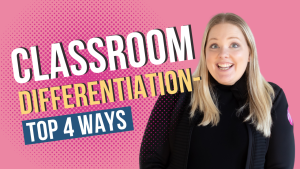Are you looking for ways to meet the diverse needs of your students better? Classroom differentiation strategies can help you tailor your lessons to individual students and create a more inclusive classroom environment. But what does differentiation actually look like in practice?

In this blog post, we’ll explore the four classroom differentiation strategies: content, process, product, and environment. Then, we’ll discuss how each type can be applied in the classroom and how to identify differentiation opportunities in your teaching practice. So, let’s dive in and ignite your teaching with effective differentiation strategies!
Differentiating the Content

In addition, you can differentiate content in whole group lessons by incorporating open-ended activities that provide multiple entry points for students. For instance, when presenting a division question, some students may use repeated subtraction to solve the problem, while others may use more advanced processes. Encouraging students to use multiple approaches to solve problems and valuing their diverse solutions can create a more inclusive and differentiated learning environment. Ultimately, by differentiating the content of your instruction, you can meet the diverse needs of your students, promote engagement, and create a more effective and inclusive learning environment.
Differentiating the Process

In math, for example, we can teach students multiple strategies for solving a problem, such as short division, long division, or the big seven. By showing them different ways to approach a problem, we allow them to find the best process for them. The same can be said for science concepts, where students may need to experience a concept in addition to reading and watching videos. For instance, students learning about erosion can benefit from hands-on experiences, like pouring sand and water into a tray to see how erosion works.
By providing multiple ways to learn, we level the playing field for students who don’t necessarily learn in the same way as others. It’s essential to recognize that there is not just one way to learn something and that different students may need different processes to succeed. As teachers, we need to design our lessons with this in mind, providing multiple types of processes to teach the same concept so that students can experience and learn in the way that suits them best.
Differentiating the Product
Try using a choice board of assessments so that students can demonstrate their knowledge and understanding using a wider variety of learning. For instance, you can create a choice board of assessments or a mini project task choice board, with nine different options that students can choose from to demonstrate their understanding and learning of a specific set of skills. For example, students could make a jersey, create a poster, write a song, do a script, or do an interview. The possibilities are endless.
When creating a rubric for differentiated products, you must focus on demonstrating the knowledge and skills. Therefore, we don’t need a separate rubric for each of the nine activities. Instead, we can assess the knowledge being demonstrated by the task. By differentiating the product, we are allowing students to showcase their learning in a way that best suits their strengths and learning style. It also allows us as educators to assess our students in a fair and more accurate way, allowing for a more well-rounded evaluation of student understanding.
Differentiating the Environment
We also need to consider the distractions that our students may encounter while working. Sitting in a low-traffic area, sitting underneath a desk, or using a privacy board can mitigate visual distractions. Students distracted by sound may require different solutions, such as noise-canceling headphones, white noise, or even classical music. It’s essential to recognize that not all students are the same and have different preferences regarding the learning environment. By providing alternate seating arrangements or environmental differentiation like sound control or privacy, students can learn and demonstrate their knowledge in a way that works best for them. Again, it’s about helping them identify their preferred conditions and how to meet those needs. By doing so, we create a comfortable and inclusive environment for all students to learn and thrive.
Start Using Classroom Differentiation Strategies
As teachers, we know that every student learns differently. That’s why differentiating instruction in your classroom is a powerful way to ensure all students can learn and succeed. By recognizing that students learn differently and tailoring instruction to meet their needs, you create a more inclusive and supportive learning environment. Differentiating content, process, product, and environment can all contribute to student success, and the key is to use various options to reach all learners. Remember, these classroom differentiation strategies are not about doing everything differently all the time but about creating a range of learning experiences for students that meet their unique needs. With a little creativity and flexibility, you can transform your classroom into a space where all students can thrive.
Watch this video to learn more!
Want to try these classroom differentiation strategies but unsure where to start?
Check out these ignited math resources that come with built-in differentiation strategies.
- Ignited Math: Grade 3 – Whole Year Bundle | Ontario Math
- Ignited Math: Grade 4 – Whole Year Bundle | Ontario Math
- Ignited Math: Grade 5 – Whole Year Bundle | Ontario Math
- Ignited Math: Grade 6 – Whole Year Bundle | Ontario Math